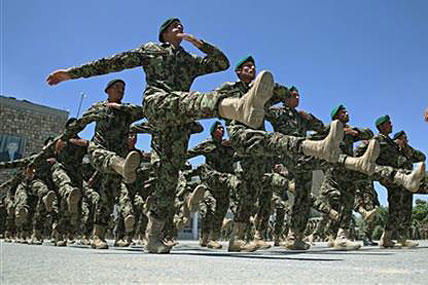The Afghan National Security Forces (ANSF) have suffered nearly 9,000 killed in action in the last two years, which is more than the total of U.S. and coalition forces killed in Afghanistan and Iraq since 2001, the No. 2 U.S. commander in Afghanistan said Wednesday.
"No, this is not sustainable" Army Lt. Gen. Joseph Anderson said of the high casualty rate in the long-term effort to defeat the Taliban and maintain a democratic Afghanistan.
"They do need to decrease their casualty rate" to maintain pressure on the Taliban and Al Qaida elements as U.S. and coalition troops complete their withdrawal of combat forces by the end of this year, said Anderson, commander of the International Security Assistance Force (ISAF) Joint Command in Kabul.
Despite the mounting death toll, "the ANSF is winning" the overall struggle to maintain the central government's mandate in the provinces, Anderson said in a video briefing from Kabul to the Pentagon.
"It is very optimistic here. The coalition's efforts here have not been in vain," he said.
Anderson said he was "not part of the assessment process"' on the sizing of the U.S. and coalition force that will be needed to back ANSF in Operation Resolute Support next year. However, he echoed Army Gen. Joseph Campbell, the lead U.S. commander in Afghanistan, in suggesting that adjustments might have to be made depending on conditions on the ground.
Campbell told Foreign Policy that he was "beginning now to take a hard look" at whether President Obama's plans to keep 9,800 U.S. troops in Afghanistan next year might have to be altered.
Campbell told Foreign Policy he was questioning whether he might have to tell the civilian leadership next year that "we need more NATO forces in certain locations for longer. I've got to do that analysis and we're just starting that now."
The Army general made similar comments in his Senate Armed Services Committee confirmation hearing last summer, when he said he would not hesitate to recommend more troops in the conditions dictated.
In the Pentagon briefing, Anderson said the plan was to have a total of 12,500 coalition troops in Afghanistan next year – 9,800 from the U.S. and about 2,700 from the allies including Germany, Italy and Turkey.
Under President Obama's plan, the number of U.S. troops in Afghanistan would be cut in half at the end of 2015 and all U.S. troops would be withdrawn at the end of 2016.
Anderson said that 4,350 Afghan troops and police were killed in 2013 and 4,634 have been killed this year through October. The total of 9,984 was greater than the total of 8,554 U.S. and coalition troops killed in the wars in Iraq and Afghanistan, according to the icasualties.org website.
The 9,800 U.S. troops in Afghanistan next year will mainly be in a training and advisory role, Anderson said, but it will include an air contingent to provide close air support for the Afghans and Special Operations Forces to carry out counter-terror missions.
The coalition began 2014 with about 54,000 troops from 48 nations and was now down to about 38,000 troops from 44 nations, including 26,000 from the U.S. The U.S. had 86 bases in Afghanistan at the start of 2014 and was now down to 26, Anderson said.
The ANSF now has a force of about 352,000, including 155,000 police, Anderson said, and one of the main goals of the U.S. follow-on force next year will be to boost the Afghan's ability to call in their own close air support, Anderson said.
New Afghan President Ashraf Ghani, who succeeded Hamid Karzai in September, has also made a difference in his brief time in office in improving coordination between the coalition and ANSF, Anderson said.
Ghani has also made a point of boosting the confidence of Afghan troops in their government, Anderson said, by visiting wounded ANSF troops in hospitals and in showing "a lot more support for their efforts."
Ghani has even "popped into police stations" late at night to check on operations, Anderson said.
-- Richard Sisk can be reached at richard.sisk@monster.com






























